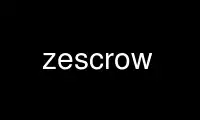
This is the command zEscrow that can be run in the OnWorks free hosting provider using one of our multiple free online workstations such as Ubuntu Online, Fedora Online, Windows online emulator or MAC OS online emulator
PROGRAM:
NAME
zEscrow - escrow a copy of ~/.ecryptfs and the mount passphrase to an escrow service
compatible with the zEscrow open API for safe keeping
SYNOPSIS
zescrow
DESCRIPTION
This interactive utility enables eCryptfs Encrypted Home and Encrypted Private users to
escrow a copy of their ~/.ecryptfs configuration and randomly generated mount passphrase
to an escrow service compatible with the zEscrow open API.
zEscrow.gazzang.com is a public implementation of the open source (AGPL) project and API
at https://launchpad.net/zEscrow. It is designed to help some eCryptfs users remotely
store a copy of their eCryptfs configuration for safe keeping, in the event that they lose
all or some of their configuration.
First, this program will prompt the user for the target zEscrow server, defaulting to the
public instance at https://zEscrow.gazzang.com. Note that a target server should have a
valid SSL certificate.
Next, it will retrieve the gpg(1) fingerprint and gpg(1) public key of the zEscrow
instance, and import it into a temporary keyring.
It will then prompt the user for their LOGIN passphrase, in order to ecryptfs-unwrap-
passphrase(1) and store the MOUNT passphrase.
Next, it will create a compressed, encrypted, encoded archive using tar(1), gzip(1), and
gpg(1), and submit it to the output to the chosen zEscrow instance using curl(1). It will
confirm the md5sum(1) with the remote server.
Note that the uploaded archive will contain ~/.ecryptfs/*, which typically includes:
- auto-umount
- auto-mount
- Private.sig
- Private.mnt
- unwrapped-passphrase
Neither your LOGIN passphrase, nor your wrapped-passphrase are ever sent to the server.
The local utility will confirm that the server's returned md5sum matches the locally
calculated value. If everything matches, the program will display a unique URL, to which
the user should navigate, where they will login using a Google OpenID account, and
associate an email address with the uploaded data. The program will offer to launch a
sensible-browser(1) to the returned URL.
Any failure whatsoever will result in a non-zero exit code, and the user should beware
that their eCryptfs configuration was NOT uploaded.
Use zEscrow online using onworks.net services
